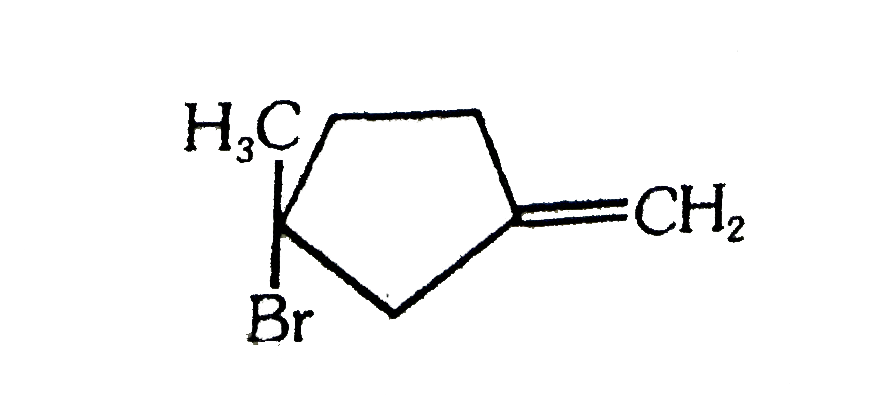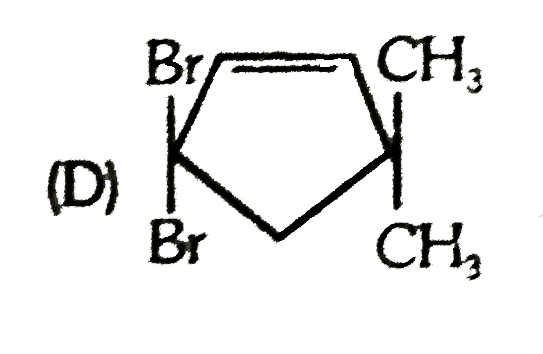An alkyl halide with molecular formula C4H5Br is optically active. What is its structure ?
To determine the structure of the alkyl halide with the molecular formula C₄H₅Br that is optically active, we can follow these steps:
Step 1: Analyze the Molecular Formula
The molecular formula C₄H₅Br indicates that we have a compound containing 4 carbon atoms, 5 hydrogen atoms, and 1 bromine atom.
Step 2: Determine the Degree of Unsaturation
To find out how many double bonds or rings are present in the structure, we can calculate the degree of unsaturation (DU). The formula for calculating DU is:
\( \text{DU} = \frac{(2C + 2 + N - H - X)}{2} \)
Where:
- C = number of carbon atoms
- H = number of hydrogen atoms
- N = number of nitrogen atoms (not applicable here)
- X = number of halogen atoms
For C₄H₅Br:
- C = 4
- H = 5
- X = 1 (for Br)
Plugging in the values:
\( \text{DU} = \frac{(2(4) + 2 + 0 - 5 - 1)}{2} = \frac{(8 + 2 - 5 - 1)}{2} = \frac{4}{2} = 2 \)
This indicates that there are 2 degrees of unsaturation, which could mean either two double bonds, one ring and one double bond, or a triple bond.
Step 3: Identify Possible Structures
Given that the compound is optically active, it must have a chiral center. A chiral center is typically a carbon atom bonded to four different substituents.
Step 4: Construct the Structure
To satisfy the molecular formula and the requirement of chirality, we can propose a structure. One possible structure is:
CH3|Br−−C−−H|CH2∣CH3
In this structure:
- The carbon atom bonded to Br, CH3, H, and CH2 is the chiral center.
- The presence of Br and the different groups around the chiral carbon ensures that the compound is optically active.
Step 5: Confirm the Structure
This structure has:
- 4 carbon atoms
- 5 hydrogen atoms
- 1 bromine atom
- A chiral center, making it optically active.
Thus, the structure of the alkyl halide with the molecular formula C₄H₅Br that is optically active is confirmed.
Final Structure
The final structure can be represented as:
CH3|Br−−C−−H|CH2∣CH3
The molecular formula C₄H₅Br indicates that we have a compound containing 4 carbon atoms, 5 hydrogen atoms, and 1 bromine atom.
To find out how many double bonds or rings are present in the structure, we can calculate the degree of unsaturation (DU). The formula for calculating DU is:
\( \text{DU} = \frac{(2C + 2 + N - H - X)}{2} \)
Where:
- C = number of carbon atoms
- H = number of hydrogen atoms
- N = number of nitrogen atoms (not applicable here)
- X = number of halogen atoms
- C = 4
- H = 5
- X = 1 (for Br)
\( \text{DU} = \frac{(2(4) + 2 + 0 - 5 - 1)}{2} = \frac{(8 + 2 - 5 - 1)}{2} = \frac{4}{2} = 2 \)
Given that the compound is optically active, it must have a chiral center. A chiral center is typically a carbon atom bonded to four different substituents.
To satisfy the molecular formula and the requirement of chirality, we can propose a structure. One possible structure is:
- The carbon atom bonded to Br, CH3, H, and CH2 is the chiral center.
- The presence of Br and the different groups around the chiral carbon ensures that the compound is optically active.
This structure has:
- 4 carbon atoms
- 5 hydrogen atoms
- 1 bromine atom
- A chiral center, making it optically active.
The final structure can be represented as:
CH3|Br−−C−−H|CH2∣CH3
Topper's Solved these Questions
- HALOALKANES AND HALOARENESBOOK - MODERN PUBLICATIONCHAPTER - HALOALKANES AND HALOARENESEXERCISE - NCERT In-text Questions
8 Videos
- HALOALKANES AND HALOARENESBOOK - MODERN PUBLICATIONCHAPTER - HALOALKANES AND HALOARENESEXERCISE - NCERT Textbooks Exercises
1 Videos
- HALOALKANES AND HALOARENESBOOK - MODERN PUBLICATIONCHAPTER - HALOALKANES AND HALOARENESEXERCISE - PRACTICE PROBLEMS
29 Videos
- EQUILIBRIUMBOOK - MODERN PUBLICATIONCHAPTER - EQUILIBRIUMEXERCISE - Unit Practice Test
13 Videos
- HYDROCARBONSBOOK - MODERN PUBLICATIONCHAPTER - HYDROCARBONSEXERCISE - UNIT PRACTICE TEST
15 Videos
Similar Questions
Knowledge Check
An organic halide with formula C6H13Br on heating with alc. KOH gives two isomeric alkene (A) and (B) with formula C6H12. On reductive ozonolysis of mixture (A) and (B) ,the following compounds are obtained :
CH3COCH3,CH3CHO,CH3CH2CHO and (CH3)2CHCHO
The organic halide is :A2-bromohexaneB3-bromo-2-methylpentaneC2, 2-dimethyl-1-bromobutaneD2-bromo-2, 3-dimethylbutaneAn optically active compound A (assume dextrorotatory) has the molecular formula C7H11Br. A reacts with hydrogen bromide, in the absence of peroxides to yield isomeric products, B and C, with the molecular formula C7H12Br2. Compound B is optically active, C is not. Treating B with 1 mol of potassium butoxide yields (+)−A. Treating C with 1 mol of potassium tert-butoxide yields (±)−A. Treating A with potassium tert-butoxide yields D(C7H10). Subjecting 1 mol of D to ozonolysis followed by treatement with zinc and acetic acid yields 2 moles of formaldehyde and 1 mole of 1,3-cyclopentanedione.

The optically active compound 'A' isA B
B C
C D
D
Number of isomers of molecular formula C2H2Br. Is :
A1B2C3D4
An acid of molecular formula, C5H10O2 is optically active. What is its structure?
View SolutionA carboxylic acid of the formula, C3H5O2Br is optically active. What is its structure?
View SolutionOn ozonolysis a hydrocarbon of molecular formula C4H6 gives succinin acid only. What is the structure of hydrocarbon ?
View SolutionTwo alkyl halides A and B with molecular formula C7H15Cl have different boiling points. These are optically active in nature. On reacting with Mg dissolved in anhydrous ether and then with water, each compound gives 2,4-dimethylpentane. Suggest structures for these compounds.
View SolutionAn alkyl halide with molecular formula C5H11 on dehydrohalogenation gave two isomeric alkenes 'A' and 'B' with molecular formula C5H10 On reductive ozonolysis. 'A' and 'B' gace four compounds CH3COCH3,CH3CHO,HCHO and (CH3)2CHCHO. The alkyl halide is :
View Solution
